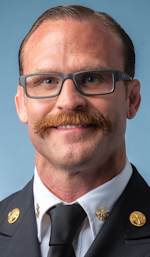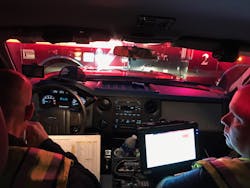Officer development programs and mentorship are integral parts of enhancing organizational members’ skill sets and provide continual organizational progress. Unfortunately, many departments don’t have this type of program. Thankfully, the dynamic and evolutionary organization I am blessed to be employed by has an excellent developmental system and mentoring process.
Bad experiences
I’ve heard many stories from people about their less-than-exceptional promotion experiences. One individual explained how nervous he was when he arrived at work as a newly promoted engineer to find out the officer was out on vacation so he was the acting captain that day. No mentorship, no development, just figure it out. As I listened to him, I could tell in his voice and by his facial expressions how much that experience taught him—learning from both the good and the bad aspects of it.
This is not unique to just this individual. This occurs in emergency service organizations all over the world. It must stop. Why would we put someone in the big leagues when they haven’t gone through the minor leagues? We must prepare our people for success, not just have them figure it out on their own.
Great mentorship
A few months ago, I began the mentoring process to become an acting battalion chief. I wanted to go through this process not only to learn the duties of a battalion chief but also to become a better company officer. On my first shift, I had the opportunity to mentor with Battalion Chief John Winn, Jr. (we call him Chief JJ). He’s a high-energy individual and always willing to teach others.
When we started the shift, he walked me around the battalion vehicle so I understood its operations and equipment as well as the normal morning check-off duties. Once we finished, we headed to his office to set up my computer so I would have all the databases I needed to perform in the acting battalion chief capacity. Once all that was set, we journeyed through the databases so he could explain the use for each one. We then proceeded to update the roster for the current shift and prepare the next shift’s roster as well. We went over the roster process for over four hours to ensure that I understood it. He then sent me on my way to complete the roster. It was great because first he taught me, then he expected me to recall the information and use it in a practical application. I finalized the roster and proceeded to timesheets, station visits, quality checking incident reports, and physical fitness. During all of this we were running responses as well.
Following the station visits, we headed back to our station for another look at the following shift’s roster to ensure we didn’t miss anything. Once that shifts roster was complete, we started the roster for the third shift. We finalized as much as we could to get ahead of the game.
The following morning, Chief JJ told me to be up at 6 a.m. to check if anyone reported out sick so we could fix the roster in a timely manner. He also explained how to give an appropriate turnover to the on-coming battalion chief. Once that was completed, I headed to another station to mentor with Battalion Chief Jack deTournillon, as I was working a buddy shift that day. He worked with me on all the aforementioned topics but also introduced me to other critical pieces of information relating to that specific response area as well as his incredible abbreviation system for incident command boards called Crew ID. In the end, I had two shifts worth of mentoring from two different battalion chiefs, both of whom taught me an enormous amount of information. Priceless.
Running the show
On my next shift as the mentoring battalion chief with Chief JJ, I had the opportunity to command an eight-unit multi-family dwelling with a working fire on the B/C corner and turbulent smoke venting from the shared attic space. We arrived on scene before any of the apparatus so I gave a size-up, performed a 360, and suddenly realized that I was not going to extinguish the fire with the little walkie-talkie I had in my hand or my battalion chief vehicle. This was my first time arriving to a structure fire without an engine and a crew to go to work. It was me, my walkie-talkie, my vehicle, my toolbox in my mind that I have worked hard to develop and my mentor, Chief JJ. Wow, was this nice to have. I’ve taken so many incident command classes that I’ve I lost count, but the real deal battalion chief job is no joke. The classes definitely prepared me, but I assure you that doing it in real life is much different.
There are a lot of moving parts in this equation. Let’s see, automatic aid with an engine and an aerial from St. Andrews Fire Department, which arrived first due with an engine and truck, a battalion chief from St. Andrews Fire Department, an excellent acting battalion chief from my department, EMS, four other engines, another ladder, multiple companies entering the structure on all four sides to extinguish the fire, perform search and rescue, ventilate, check for extension, set up rehab, etc., not to mention that we need a safety officer and an accountability officer, and we need the electric company.
Chief Charles Lamoreaux, the mutual-aid fire chief, arrives. The ladder is ready to ventilate, the attack crew is getting a knock on the fire, my mentor (Chief JJ) is constantly talking in my ear (love this guy), the assistant chief of operations, Chief Joey Roberts, is standing outside the command vehicle looking at me, and the interim fire chief, Chief John B. Tippett Jr., gets in the vehicle as the senior advisor and sits behind me. Outside we have the water supply team, the backup team and the RIT team. Bystanders are everywhere, and now the Red Cross is at the command vehicle. Deep breath. In through the nose, out through the mouth. It’s time to organize all of this. Thankfully, all of the crews from both departments on scene did an excellent job and extinguished the fire quickly.
While I was setting up my command board, Chief JJ was assisting me in the process but also letting me do the job. If I missed something, he would let me know so I could fix it. You could tell the passion he had in teaching me during the incident. He was there with me through the entire process. From operations to salvage, to organizing with the Red Cross for the eight displaced families, to meeting with the fire inspector, to terminating the incident, to writing the report, and finally, reviewing the incident. Priceless.
Internally, I was smiling throughout this entire command process because this is how you learn—education, experience, practical application and stress inoculation, coupled with the mentorship and guidance of others who have been there and done that. How would you like to command that incident your first day as an acting battalion chief without any developmental work, education, courses on incident command, mentorship or guidance? Unfortunately, some of you have done just that—because you had to. My hat’s off to you. Much respect. However, it’s a different world today and, quite frankly, we know better now.
When I finish my 10 24-hour shifts of mentoring in all four battalions with multiple battalion chiefs, I will have learned an enormous amount of skills to prepare me to be an acting battalion chief. These skills range from administrative all the way to commanding a structure fire and anything in between. I couldn’t imagine one day just jumping in the battalion chief vehicle thinking I could do that job without the mentorship from the battalion chiefs I worked with. They gave me great feedback on areas where I was doing well but also areas where I needed to improve. This was so helpful for me. I now have a roadmap, thanks to our developmental process and my incredible mentors.
How the process works
Here in Charleston, when someone is promoted to engineer they complete our Officer Development Program, which is two weeks long. They are taught by internal and external instructors on the core components of being an officer. Once they complete this class and have one year as an engineer, they are then placed on a rig as a mentoring captain, meaning the “real” captain rides the back with another firefighter while the mentoring captain rides the seat as the officer. The mentoring captain makes the decisions and runs the company with the guidance of the real captain. The mentoring captain does this process for 10 24-hour shifts. Wow. Can you imagine how much you learn in these 10 shifts? I can, because I went through this process in 2010 as one of the first classes. It was incredible.
Once the mentor shifts are completed, the real captain completes an evaluation of the mentoring captain and recommends them for acting status if they are proficient in all areas. Following this, the mentoring captain can officially act as a captain on their own. Next, they must be an engineer for three to four years, depending on educational courses completed, before they can test for captain. What does this mean for development? Well, they act as the officer numerous times over this three- to four-year period, gaining priceless education and experience.
We have this process with a second Officer Development Program and mentorship system for battalion-level skills. Couple that with 10 24-hour shifts of mentorship with multiple battalion chiefs in all four battalions and you have a well-prepared acting or promoted battalion chief. Priceless education, experience and mentorship.
In sum
The moral of the story is this: We must prepare our people. If we’re not preparing them, we have no one to blame but ourselves when mistakes occur. Granted, all this education, experience and mentorship won’t entirely diminish problems and mistakes. However, it will greatly reduce them. Remember, we are dealing with human behaviors in a complex work atmosphere. We can’t just expect our people to figure out what to do in the ever-changing administrative, technological and operational environment in which we work. As the Brunacinis state, “standard conditions + standard actions = standard outcomes.” Officer development and mentorship are essential keys to this.
Thank you to the officers who worked with me in the officer development program: Battalion Chiefs Ricky Williams, Forest Cockcroft, John Winn, Jr., John Cole, Larry Hood, Greg Chesher, Robert Baldwin as well as Acting Battalion Chiefs Lance Williams, James Richardson and Kevin Weeks. Thank you all for your guidance and mentorship. I am and will always be greatly appreciative of it.

Dr. David Griffin
Dr. David Griffin is the assistant chief of administration in Charleston, SC. He was the operator of the first-due engine on June 18, 2007, when nine of his fellow firefighters perished. Griffin has come through the ranks in operations in every uniformed position, from firefighter to battalion chief and shift commander to his current position, during his 19-year career in Charleston. He has a bachelor's degree in education from The Citadel, a master's degree in executive fire service leadership, and a doctorate of education in organizational leadership and development. Griffin is the author of "In Honor of The Charleston 9: A Study of Change Following Tragedy," among three other books. He is an international speaker and instructor, a certified Chief Fire Officer and Chief Training Officer with The Center for Public Safety Excellence, an IFSAC/Pro Board-certified Fire Officer IV and a graduate of the Executive Fire Officer Program from the National Fire Academy. He is a graduate of Harvard University's Kennedy School of Executive Education program: Senior Executives in State and Local Government and of the Psychology of Leadership program at Cornell University's SC Johnson College of Business. Griffin is the owner of On A Mission, LLC, at drdavidgriffin.com.






